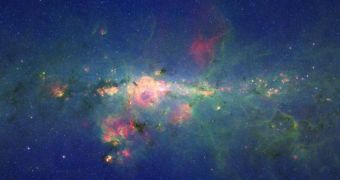A group of investigators has just released a new version of a standard image depicting the core of our galaxy. The new view places an emphasis on determining the number and type of stars that exist near the center of the Milky Way.
Even at a brief glance, it becomes apparent that the central regions of the 100,000-light-year galaxy are jam-packed with stars, giving it a bluish color that brightens the closer the view gets to the core.
Astronomers believe that a supermassive black hole resides at the core of the cosmic structure, powering it up by accreting large amounts of material from its surroundings. Many of the stars in this new view, especially those at the center, revolve around this dark behemoth.
The original image of the Milky Way core was taken using the NASA Spitzer Space Telescope, which surveys the sky in infrared wavelengths. The reason this observatory was used is that visible-light detectors cannot pierce through the massive dust clouds surrounding the region.
Infrared light detectors can “see” the heat signature of stars and other celestial objects regardless of how much dust and hydrogen gas gets in the way. This particular view covers 120 degrees.
Scientists at the NASA Jet Propulsion Laboratory (JPL) in Pasadena, California, have now made the same view available, but at a different contrast, and focused around the central areas of the galaxy.
“The green features are from carbon-rich dust molecules, called polycyclic aromatic hydrocarbons, which are illuminated by the surrounding starlight as they swirl around the galaxy's core,” a JPL press release explains.
“The yellow-red patches are the thermal glow from warm dust. The polycyclic aromatic hydrocarbons and dust are associated with bustling hubs of young stars. These materials, mixed with gas, are required for making new stars,” the statement adds.
Even though about 10 billion years old, the Milky Way is still producing young blue stars in its stellar nurseries, but at much lower paces than it did in the past. Only galactic collisions can not increase the rate of stellar production in cosmic structures such as our own.
But the galaxy is not scheduled to bump into another until 5 billion years from now, when it will begin to collide with the Andromeda Galaxy, which is currently rushing towards us. This will be about the same time that the Sun reaches the end of its burning cycle.
“The region pictured here is immense, with a horizontal span of 2,400 light-years (5.3 degrees) and a vertical span of 1,360 light-years (3 degrees),” JPL experts go on to say.
“Though most of the objects seen in this image are located near the galactic center, the features above and below the galactic plane tend to lie closer to Earth,” they conclude.
Data from the Galactic Legacy Infrared Mid-Plane Survey Extraordinaire (GLIMPSE) project and the Multiband Imaging Photometer for Spitzer Galactic survey (MIPSGAL) were also used in this image.

 14 DAY TRIAL //
14 DAY TRIAL //